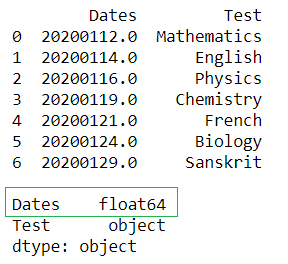How to Convert Float to Datetime in Pandas DataFrame?
Last Updated :
29 Aug, 2020
Pandas Dataframe provides the freedom to change the data type of column values. We can change them from Integers to Float type, Integer to Datetime, String to Integer, Float to Datetime, etc. For converting float to DateTime we use pandas.to_datetime() function and following syntax is used :
Syntax: pandas.to_datetime(arg, errors=’raise’, dayfirst=False, yearfirst=False, utc=None, box=True, format=None, exact=True, unit=None, infer_datetime_format=False, origin=’unix’, cache=False)
Example 1: Converting one column from float to ‘yyyymmdd’ format using pandas.to_datetime()
Python3
import pandas as pd
player_list = [[20200112.0,'Mathematics'],
[20200114.0,'English'],
[20200116.0,'Physics'],
[20200119.0,'Chemistry'],
[20200121.0,'French'],
[20200124.0,'Biology'],
[20200129.0,'Sanskrit']]
df = pd.DataFrame(player_list,columns=['Dates','Test'])
print(df)
print()
print(df.dtypes)
|
Output:

After changing the datatype.
Python3
df['Dates'] = pd.to_datetime(df['Dates'], format='%Y%m%d')
print(df)
print()
print(df.dtypes)
|
Output:

In the above example, we change the data type of column ‘Dates‘ from ‘float64‘ to ‘datetime64[ns]‘ type.
Example 2: If the data frame column is in yymmdd format and we have to convert it to yyyymmdd format
Python3
import pandas as pd
player_list = [[180112.0,'Mathematics'],
[180114.0,'English'],
[180116.0,'Physics'],
[180119.0,'Chemistry'],
[180121.0,'French'],
[180124.0,'Biology'],
[180129.0,'Sanskrit']]
df = pd.DataFrame(player_list,columns=['Dates','Test'])
print(df)
print()
print(df.dtypes)
|
Output:

After changing the datatype.
Python3
df['Dates'] = pd.to_datetime(df['Dates'], format='%y%m%d')
print(df)
print()
print(df.dtypes)
|
Output:

In the above example, we change the data type of column ‘Dates‘ from ‘float64‘ to ‘datetime64[ns]‘ and format from ‘yymmdd‘ to ‘yyyymmdd‘.
Example 3: When we have to convert the float column to Date and Time format
Python3
import pandas as pd
player_list = [[20200112082520.0,'Mathematics'],
[20200114085020.0,'English'],
[20200116093529.0,'Physics'],
[20200119101530.0,'Chemistry'],
[20200121104060.0,'French'],
[20200124113541.0,'Biology'],
[20200129125023.0,'Sanskrit']]
df = pd.DataFrame(player_list,columns=['Dates','Test'])
print(df)
print()
print(df.dtypes)
|
Output:

After changing the datatype.
Python3
df['Dates'] = pd.to_datetime(df['Dates'], format='%Y%m%d%H%M%S')
print(df)
print()
print(df.dtypes)
|
Output:

In the above example, we change the data type of column ‘Dates‘ from ‘float64‘ to ‘datetime64[ns]‘ and format to Date and Time
Example 4: Converting multiple columns from float to ‘yyyymmdd‘ format using pandas.to_datetime()
Python3
import pandas as pd
player_list = [[20200112.0,'Mathematics',20200113.0],
[20200114.0,'English',20200115.0],
[20200116.0,'Physics',20200117.0],
[20200119.0,'Chemistry',20200120.0],
[20200121.0,'French',20200122.0],
[20200124.0,'Biology',20200125.0],
[20200129.0,'Sanskrit',20200130.0]]
df = pd.DataFrame(player_list,columns=['Starting_Date','Test','Ending_Date'])
print(df)
print()
print(df.dtypes)
|
Output:

After changing the datatype.
Python3
df['Starting_Date'] = pd.to_datetime(df['Starting_Date'],
format='%Y%m%d')
df['Ending_Date'] = pd.to_datetime(df['Ending_Date'],
format='%Y%m%d')
print(df)
print()
print(df.dtypes)
|
Output:

In the above example, we change the data type of columns ‘Starting_Date‘ and ‘Ending_Date‘ from ‘float64‘ to ‘datetime64[ns]‘ type.
Like Article
Suggest improvement
Share your thoughts in the comments
Please Login to comment...